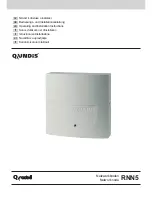
1
Introduction
10/100 16-Port VPN Router
Chapter 1
Chapter 1:
Introduction
Introduction to the Router
Thank you for choosing the Linksys 10/100 16-Port VPN
Router. The Router lets multiple computers in your office
share an Internet connection, and its 16 ports offer
versatility.
Two are dedicated Internet ports that let you connect
a second Internet line as a backup, or you can use both
Internet ports at the same time, allowing the Router to
manage bandwidth demands for maximum efficiency.
Up to five of the 13, full-duplex, 10/100 local ports can
be reconfigured as Internet ports, for an up to seven-port
failover or load balanced redundancy. A dedicated DMZ
port gives you a publicly accessible channel so you can set
up a web or FTP server.
For remote connections, up to 50 remote office or traveling
users can securely connect to your office network using
the Router’s Virtual Private Network (VPN) capability.
Use the browser-based utility to configure settings and
run convenient wizards that will help you set up the
Router and its access rules.
Introduction to VPNs
A VPN is a connection between two endpoints—a VPN
Router, for instance—in different networks that allows
private data to be sent securely over a shared or public
network, such as the Internet. This establishes a private
network that can send data securely between these two
locations or networks.
The private network is established by creating a “tunnel”.
A VPN tunnel connects the two computers or networks
and allows data to be transmitted over the Internet
as if it were still within those networks. A VPN tunnel
uses industry-standard encryption and authentication
techniques to secure the data sent between the two
networks.
Virtual Private Networking was created as a cost-effective
alternative to using a private, dedicated, leased line for a
private network. It can be used to create secure networks
linking a central office with branch offices, telecommuters,
and/or professionals on the road.
There are two basic ways to create a VPN connection:
VPN Router to VPN Router
•
computer (using VPN client software) to VPN Router
•
The VPN Router creates a “tunnel” or channel between two
endpoints, so that data transmissions between them are
secure. A computer with VPN client software can be one
of the two endpoints.
For an IPSec VPN tunnel, the VPN Router and any computer
with the built-in IPSec Security Manager (Windows 2000
and XP) can create a VPN tunnel using IPSec (Windows
Vista uses a similar utility). Other Windows operating
systems require additional, third-party VPN client software
applications that support IPSec to be installed.
NOTE:
The 10/100 16-Port VPN Router supports
IPSec VPN client software, including the Linksys
QuickVPN software. (For more information, refer
to “Appendix B: Linksys QuickVPN for Windows
2000, XP, or Vista”.)
For a PPTP VPN tunnel, the 10/100 16-Port VPN Router and
any computer running Windows 2000 or XP can create a
VPN tunnel using PPTP.
VPN Examples
The following are examples of a VPN tunnel between two
VPN routers and a VPN tunnel between a computer using
VPN client software and a VPN router.
VPN Router to VPN Router
For example, at home, a telecommuter uses his VPN
Router for his always-on Internet connection. His Router
is configured with his office’s VPN settings. When he
connects to his office’s router, the two routers create a
VPN tunnel, encrypting and decrypting data. As VPNs use
the Internet, distance is not a factor. Using the VPN, the
telecommuter now has a secure connection to the central
office’s network, as if he were physically connected.









































